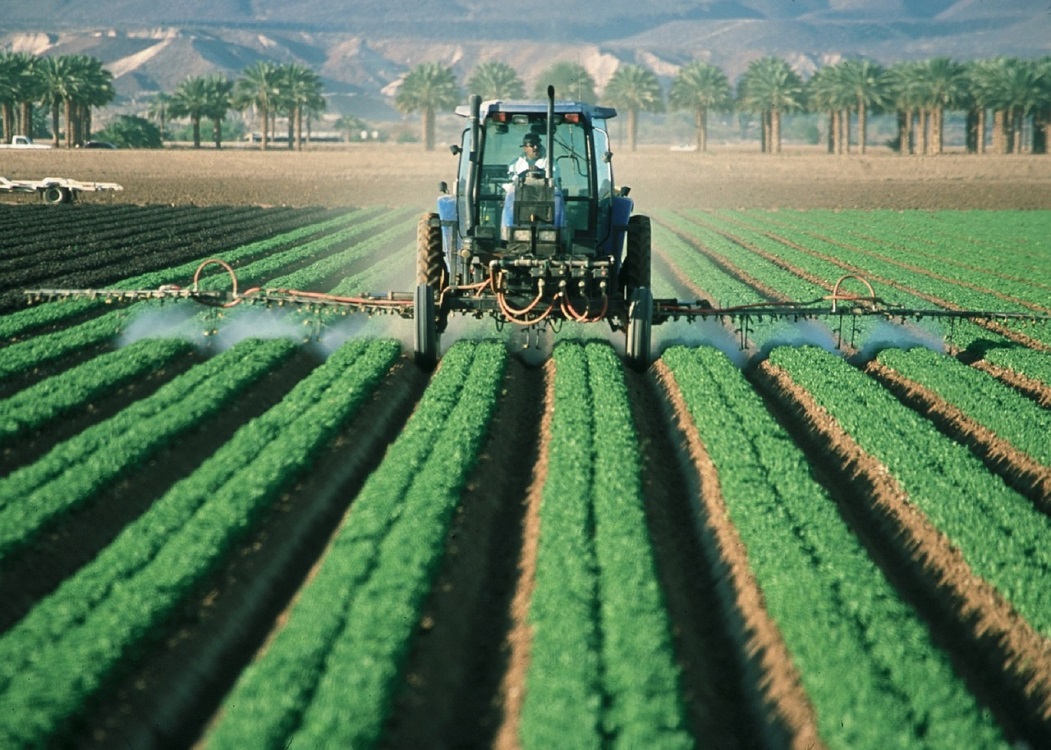In recognition of this special awareness day, this feature article aims to illustrate how cutting-edge research at STFC's CLF and ISIS Neutron and Muon Source is revolutionising what we know about food science and paving the way for future global food security.
Agriculture and Food Security
One of the biggest challenges of the 21st century is ensuring that we have enough food to feed the seven billion and counting people on our planet. Whilst the logistics of achieving this aim are still being debated, the end goal is for certain; for the world to achieve something called 'Food Security.'
Food security is a term used to describe a situation in which people have access to safe, nutritious food, at all times, that is plentiful and obtained in sustainable ways. As the world only has a limited number of resources, we need to look at new, inventive ways of increasing crop yields and improving the efficiency of agriculture. This is where research at the CLF and ISIS fits in.
In 2016, for example, scientists from the University of Manchester used neutron reflectometry on ISIS's INTER instrument to investigate how the fine-tuning of pesticide formulations could further increase crop yields. As part of a project supported by the agrochemical company, Syngenta, the team used a self-built model of the leaf's waxy surface to study how surfactants found in pesticide formulations interact with the leaf surface and thus go on to take effect. The INTER instrument helped the scientists characterise the wax model, revealing details about its structure. For example, they found that the wax was made up of a thin, underlying film covered by large crystalline structures. Neutrons from INTER also allowed them to decipher the thickness of the wax films and the change in density over the thickness range. With this information on board, they could determine how much water was penetrating into the leaf and therefore gain a greater understanding of the mechanism by which water diffuses through a plant. The results of the team's experiments at ISIS are pioneering as by increasing our understanding of the way pesticides penetrate the waxy layer on leaf surfaces, scientists will be able to improve the efficacy of products in the future. A greater number of longer-lasting crops mean higher food security – a key issue that we need to address in the years to come as the world population soars and food poverty rises.
Four years beforehand at the CLF, a breakthrough discovery occurred at the Octopus imaging facility. A team from Oxford Brookes University successfully demonstrated how plants may defend themselves in the face of pathogen attacks, a feat that may well be the missing jigsaw piece in the puzzle of making crops more disease-resistant and boosting food production. The BBSRC-funded project led by Dr John Runions involved the use of a unique technique known as single-molecule tracking, which finally provided answers to a fundamental question scientists have been pondering up for years: Why is it that plant cells are less mobile than their counterparts in animal cells?
Plant cells, unlike animal cells, have a thin surrounding barrier called the cell wall, which provides the cell with structure and helps guard it from the perils of the external environment. One of the functions of said cell wall is to control the mobility of proteins produced when a cell comes under attack from disease-causing microorganisms. Using advanced imaging techniques at the CLF, the team could observe the movement of individual molecules in living plant cells for the first time, revealing that upon attack, the cell wall stabilises proteins in the plasma membrane, restricting their diffusion and ability to fight invading pathogens, and as a result increasing their vulnerability to infection. Manipulation of such knowledge of fundamental plant biology will help scientists to improve the resilience of crops in the future as Dr John Runions explained:
“This vital advance in our knowledge of the fundamental biological processes that take place in living plant cells will help us to improve crop's resilience and their ability to meet the challenges posed not just by diseases and pests but also by drought and a warming climate."
Another issue that we face when it comes to food security is the management of livestock. Indeed, on average, people around the world consume 75 pounds of meat per person, per year. With poultry being the fastest growing meat sector, there is a greater-than-ever need for high productivity. However, a threat is emerging in the form of a virus responsible for a disease known as Infectious Bursal Disease or Gumboro's disease. Thankfully, in 2014, scientists at the ISIS Neutron and Muon Source revealed a set of experimental results that could change the way we deliver vaccines against this highly contagious disease.
In an initial proof-of-concept experiment, a team from the University of Greenwich used the LOQ and SANS2D instruments at ISIS to characterise a new oral vaccine delivery system, developed in the laboratory. Dr Simon Richardson and his team used a complex of silica, protein and a fatty acid called myristic acid - a derivative of nutmeg. The silica bead - an ideal delivery agent as it is present in a chicken's diet where it helps with digestion - was wrapped in protein which was buffered to be positively charged in order to react with the negatively charged silica. Both these components were then coated in myristic acid which keeps the complex stable in the stomach by protecting it against chicken proteases - enzymes which digest proteins. Upon intestinal entry, however, the complex releases its surrounding protein layer allowing it to be surveyed by the immune system, initiating the key immune response which makes vaccines effective. Their results provide a promising alternative to conventional vaccination methods which are often labour-intensive, costly and time-consuming.

Image credit: Pixabay
Food Storage
As we strive to increase product yields, we also need to shift our attention towards the mechanisms that we use to store perishable food, whilst being conscious of the sustainability of such systems. For example, as the world becomes more aware of the consequences of climate change, there is greater knowledge of the harmfulness of pollutants and the serious effects they can have on the earth's atmosphere. A prime example of such a pollutant is hydrofluorocarbons, found in traditional fridges like the ones we use to store food in our homes.
Standard fridges keep contents cool by absorbing heat as a gas is condensed into a liquid. The only problem is the gases used in conventional refrigerants are often volatile organic compounds such as hydrofluorocarbons. To make matters worse, they are also potent greenhouse gases meaning they can do serious damage to the environment if they ever escape. A cleaner, safer solution is therefore of tremendous value.
In 2010, a team of scientists from Imperial College London, Cambridge University and the ISIS Neutron and Muon Source used high-resolution neutron diffraction to observe how a material called CoMnSi behaves at high temperatures and in strong magnetic fields. Their results could lead to more efficient, safer fridges and cooling systems.
Lead scientist Dr Karl Sandeman and his team used the HRPD instrument at ISIS to see if there was a magnetic change in the material that coincided with another property of the material, such as a change in the position or crystal structure of its atoms. These changes are known as 'first order' transitions and they occur very quickly at a particular temperature during a phenomenon called 'giant magneto-elastic coupling.' What's great is that this sharp switch in magnetic state is capable of producing a similar cooling effect to that found in conventional fridges. With further development and design of the technique, we might well see magnetic fridges in the future. As magnetic refrigeration use solid refrigerants, rather than gas, there is no potential for harmful gas leaks when used as a cooling system. This would mean a much cleaner, more sustainable method of storing food in our homes could be right around the corner. This is all very good news for the planet as Dr Sandeman explains;
“One recent study predicted that by 2050, between 28-45% (C02-equivalent basis) of projected global CO2 emissions will be due to hydrofluorocarbons. Using magnetic refrigeration could produce cooling systems that are more energy efficient, emit less noise, and are less harmful to the environment."

Image credit: Pixabay
Overall, scientists at ISIS and the CLF are looking not only at how we can improve yields of food, but also how we can store it in a more sustainable manner. Whilst the examples featured in this article allude to experiments completed over the past few years, food science research at the CLF and ISIS is only getting more extensive. Collaborative efforts are also at the forefront in our shared global mission to provide enough food for all.
For example, scientists have recently been combining data from neutrons at ISIS, on the INTER instrument, and X-rays from the Diamond Light Source to paint a clearer picture of water and mineral distribution in soil and plants. As neutrons are sensitive to water, neutron imaging can reveal details about water uptake and distribution, whilst X-rays can do the same for minerals. Together, these two imaging techniques can be applied to the study of all sorts of crops, from rice to maize to wheat. Future experimental data might then be used in a bunch of possible investigations, including looking into the quality of soil and conserving water as we bid to increase crop yields on limited resources. All in all, the potential of the instruments at the ISIS Neutron and Muon Source and the lasers at the CLF is huge and their application to food research shows incredible promise for the future.
This just goes to show that whilst the potential of using individual instruments at the ISIS Neutron and Muon Source and lasers at the CLF is huge, if you combine the efforts of multiple departments and organisations working together with one shared goal, the possibilities are really amazing. Together we can create a world where everyone has access to good- quality, nutritious food.

To learn more about World Food Day 2018 and what you can do to get involved, please visit this link.
To find out more about the UK cross-government programme on food security, please follow this link
For science highlights at ISIS please visit this link.
